In the fast-changing online money-making world, Google Adsense has been a go-to choice for many. But what if you want to explore other options to add variety to your earnings or because Adsense doesn’t match your website? That’s where this guide steps in. We will check out more than 10 of the best Google Adsense alternatives for 2024 to help you choose wisely and increase your online earnings.
Diversifying your income sources can be a smart move. Instead of relying solely on Adsense, you can consider other ad networks like Media.net, Infolinks, or PropellerAds. These platforms offer different ways to monetize your website, such as native ads, display ads, or in-text ads.

Additionally, affiliate marketing with Amazon Associates or ShareASale can be lucrative. Don’t forget about sponsored content, selling digital products, or offering premium subscriptions. It’s all about finding what suits your website and audience the best. So, explore these alternatives and decide to boost your online income in 2024.
10+ Best Google Adsense Alternatives 2024
Before we begin, let us remind you that the order of the Google AdSense alternatives below is random. Everything is good. Just adjust it to your taste and type of blog.
1. AdNow
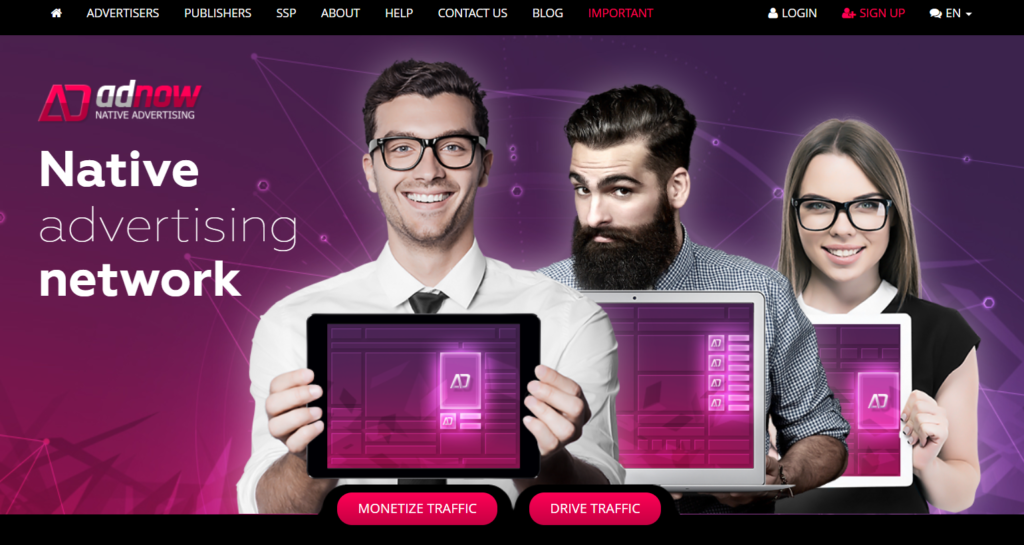
AdNow is an exceptional choice for publishers seeking a user-friendly ad platform that seamlessly integrates with their content, maintaining a smooth and uninterrupted user experience. This native advertising network excels in several aspects, making it a top choice for many website owners.
Pros:
- Non-Intrusive Native Ads: AdNow’s native ads blend seamlessly with your website’s design and content, avoiding the disruptive and jarring experience often associated with traditional ads. This integration ensures visitors remain engaged with your content, creating a more pleasant user experience.
- User-Friendly Setup: AdNow’s user-friendly interface simplifies the setup process, allowing even novice publishers to implement the platform quickly. This convenience saves time and effort, making it an attractive option for those who want a hassle-free advertising solution.
- Regular Payouts: AdNow ensures regular and reliable payouts to its publishers. This financial stability provides peace of mind for website owners, allowing them to focus on content creation and audience engagement without worrying about payment delays or uncertainties.
Read Also: How to Turn Off Memories on iPhone in 2024
Cons:
- Limited Ad Control: Publishers have less control over the content and quality of ads displayed on their site, which can sometimes result in ads not entirely aligned with their brand or audience.
- Ad Relevance Challenges: Achieving optimal ad relevance can be challenging, as the platform relies on algorithms to determine which ads to display. This may lead to occasional mismatches with your content.
- Potential Impact on SEO: Overuse of native ads, even non-intrusive ones, can impact SEO if not implemented judiciously. Website owners should carefully balance content and ads to avoid any negative SEO consequences.
2. MediaNet
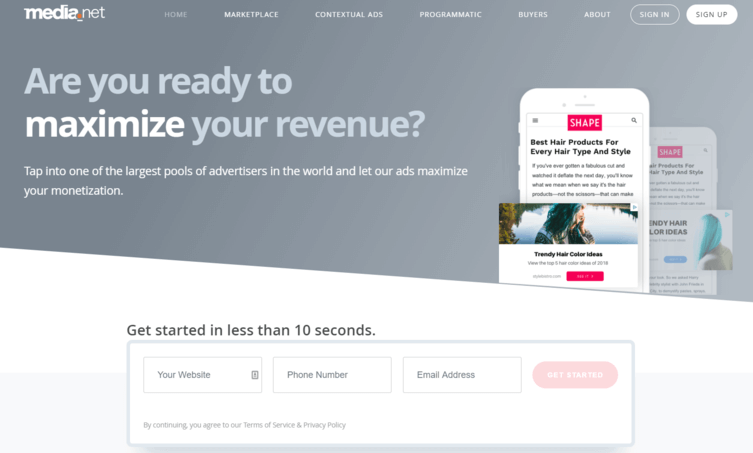
MediaNet is a renowned advertising platform, known for its specialization in contextual ads that seamlessly integrate with your content. This service excels in delivering highly relevant advertisements to your audience, ensuring a more engaging and non-intrusive user experience. With a vast and diverse pool of advertisers, MediaNet offers the potential for competitive revenue generation, making it a top-tier alternative to AdSense.
Pros:
- Contextual Relevance: MediaNet’s strength lies in its ability to deliver ads that align perfectly with your content, increasing the likelihood of user interaction and conversion.
- Diverse Advertisers: The platform boasts an extensive array of advertisers, providing website owners with a broader range of options and opportunities to maximize revenue.
- User-Friendly Interface and Support: MediaNet offers an intuitive interface that simplifies ad management and optimization. Their excellent customer support also ensures users receive assistance when needed, enhancing the overall experience.
Cons:
- Traffic Requirements: MediaNet might have traffic requirements that can be challenging for new or smaller websites, limiting access for some publishers.
- Geographical Limitations: MediaNet’s coverage may not be as extensive as AdSense, which could affect revenue potential in certain geographical regions.
- Varied Performance: While MediaNet generally provides competitive revenue, actual performance can vary and may not be as consistent as other advertising platforms.
3. Propeller Ads

Propeller Ads is a versatile advertising platform that offers a wide range of ad formats to cater to diverse marketing needs. With an array of advertising options, including push notifications, interstitial ads, and more, Propeller Ads provides advertisers with a comprehensive toolkit to engage their target audience effectively.
Pros:
- Diverse Ad Formats: Propeller Ads offers an extensive selection of ad formats, allowing advertisers to choose the one that best suits their campaign objectives. Whether it’s push notifications for real-time engagement or interstitial ads for immersive experiences, the platform offers flexibility.
- Anti-Ad-Block Technology: Propeller Ads’ anti-ad-block technology is a significant advantage. It ensures that your ads are displayed to your audience, bypassing ad-blockers. This feature can help increase the visibility and reach of your advertising efforts.
- Global Reach: With a global reach, Propeller Ads can connect your brand with a vast and diverse audience. This is particularly valuable for businesses aiming to expand their market presence on a global scale.
Cons:
- Quality Control: Some users have reported concerns about the quality of traffic generated through Propeller Ads. Advertisers need to monitor campaigns closely to ensure they are reaching a relevant audience.
- Complexity: The variety of ad formats and features can be overwhelming for beginners. Advertisers might require time and effort to master the platform’s intricacies.
- Cost: While Propeller Ads offers a broad range of ad formats, some of them may come at a higher cost. Advertisers need to consider their budget and ROI carefully.
4. Infolinks
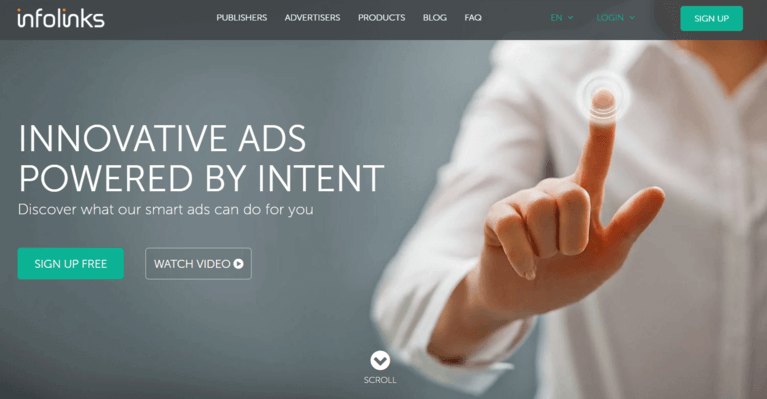
Infolinks, a versatile advertising platform, provides an array of ad types, including in-text ads, in-frame ads, and in-fold ads, enhancing the flexibility of website monetization strategies. Their commitment to responsiveness ensures a seamless user experience across all devices, a pivotal advantage for modern web content.
Pros:
- Ad Variety: Infolinks’ diverse ad formats cater to different web content and audience preferences. In-text ads seamlessly integrate into the content, in-frame ads occupy the page margins, and in-fold ads appear dynamically as users scroll. This variety enables website owners to choose the most suitable ad type for their specific audience and content.
- Responsive Ads: Infolinks’ responsive design ensures that ads adapt fluidly to various screen sizes and devices. This compatibility enhances user engagement and experience, as visitors can access content without disruption on desktops, tablets, or smartphones.
- User Experience: Infolinks’ non-intrusive ad placements like in-text ads help maintain a positive user experience. By avoiding disruptive pop-ups or interstitial ads, it minimizes the risk of driving visitors away from the website.
Cons:
- Earnings: While Infolinks offers various ad types, some users may find the revenue generated comparatively lower than other ad networks, particularly for smaller websites with limited traffic.
- Competition: The ad space is highly competitive, and Infolinks faces stiff competition from established giants like Google AdSense and Amazon Associates. This can make it challenging for publishers to secure premium advertising rates.
- Ad Relevance: Ensuring ad relevance to the content can be a concern. Infolinks’ algorithms may not always deliver ads that align perfectly with the website’s subject matter, potentially leading to lower click-through rates.
5. RevContent

RevContent is widely recognized for its premium content recommendation platform, attracting websites with high-quality content due to its stringent content guidelines. This selectivity has both advantages and disadvantages, making it a preferred choice for some while leaving others seeking alternative options.
Pros:
- High Earnings Potential: RevContent’s commitment to premium content ensures that advertisers are willing to pay top dollar for ad placements. This can translate to substantial earnings for publishers who meet their stringent standards, making it an appealing choice for content creators looking to monetize their websites effectively.
- Quality Control: The strict content guidelines maintained by RevContent promote a safer and more user-friendly browsing experience. This emphasis on quality content helps maintain the integrity of the platform and ensures that users are exposed to valuable and relevant recommendations.
- Reputation and Trust: Websites using RevContent are often associated with quality, which can enhance their reputation and trustworthiness among users. This can lead to increased traffic and engagement as users are more likely to trust the content and recommendations presented.
Cons:
- Stringent Requirements: The high content standards can be a barrier for some publishers, as not all websites can meet the criteria set by RevContent. This exclusivity can limit the platform’s accessibility.
- Competition: With the focus on premium content, the competition for ad placements can be intense. Smaller or newer websites may struggle to secure advertisers, as preference is often given to more established publishers.
- Limited Flexibility: The strict guidelines might limit creative freedom for some content creators, as they need to adhere to RevContent’s rules, potentially constraining their ability to express themselves or their brand’s identity.
6. Adsterra
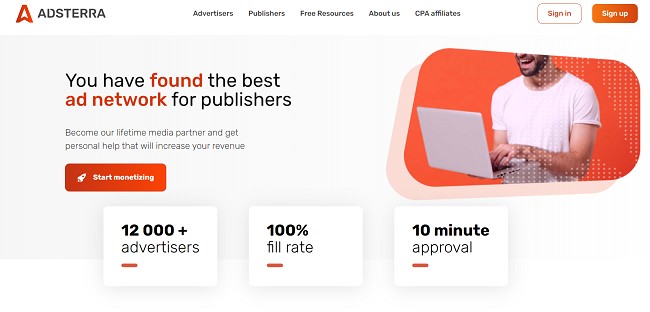
Adsterra stands out as an exceptional choice for publishers seeking a robust ad network. This platform offers a plethora of ad formats, ensuring you have a wide array of monetization options at your disposal. It’s an enticing prospect for publishers, and here’s why:
Pros:
- Diverse Ad Formats: Adsterra’s versatility is a major plus. It caters to a variety of content types with a wide range of ad formats, including pop-unders, push notifications, display banners, and more. This versatility allows publishers to tailor their ad strategy to their specific audience and content, maximizing revenue potential.
- High CPM Rates: Adsterra is known for its competitive CPM rates, providing publishers with the opportunity to earn more from their website traffic. This can significantly boost the profitability of your online venture.
- Prompt Payments: Publishers appreciate Adsterra’s commitment to timely payments. They ensure that you receive your earnings on schedule, which is crucial for maintaining a steady cash flow and building trust in the partnership.
Cons:
- Strict Approval Process: Adsterra maintains stringent approval procedures, which might pose challenges for some publishers. Your website must meet certain criteria, and not all websites will be accepted into their network.
- Limited Customer Support: Some users have reported issues with customer support responsiveness. When facing problems or needing assistance, it can be frustrating to encounter delays in resolving issues.
- Ad Quality Control: While Adsterra offers various ad formats, some publishers have voiced concerns about the quality and relevance of certain ads, which could potentially affect the user experience and site credibility.
7. PopAds
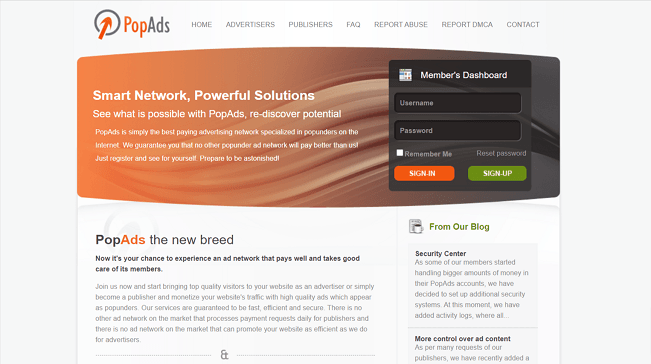
PopAds is a prominent advertising network that specializes in pop-under ads, a less intrusive ad format that appears behind the main browser window. This approach offers several advantages, making it an attractive option for publishers and advertisers.
Pros:
- Excellent International Fill Rates: PopAds is known for its impressive fill rates, which means that it effectively monetizes international traffic. This is advantageous for publishers with a global audience, as it maximizes revenue potential.
- User-Friendly Format: Pop-under ads are generally considered less intrusive than pop-ups. They appear in the background, allowing users to continue their browsing without immediate disruption, which can result in a better user experience and reduced ad-blocking.
- Flexible Targeting Options: PopAds provides robust targeting options, allowing advertisers to reach specific demographics, geographies, and interests. This level of granularity can enhance the effectiveness of ad campaigns.
Cons:
- Quality of Ads: PopAds may not always guarantee the highest quality of ads. Advertisers have varying standards, and some ads may not align with a publisher’s content, potentially affecting the user experience.
- Potential for Abuse: Some advertisers may abuse the pop-under format by displaying aggressive or misleading ads, which can tarnish the reputation of publishers using such ads and negatively impact user trust.
- Ad-Blocking Concerns: While pop-unders are less intrusive, they can still be blocked by certain ad-blockers, reducing the revenue potential for publishers and the reach of advertisers.
8. Evadav
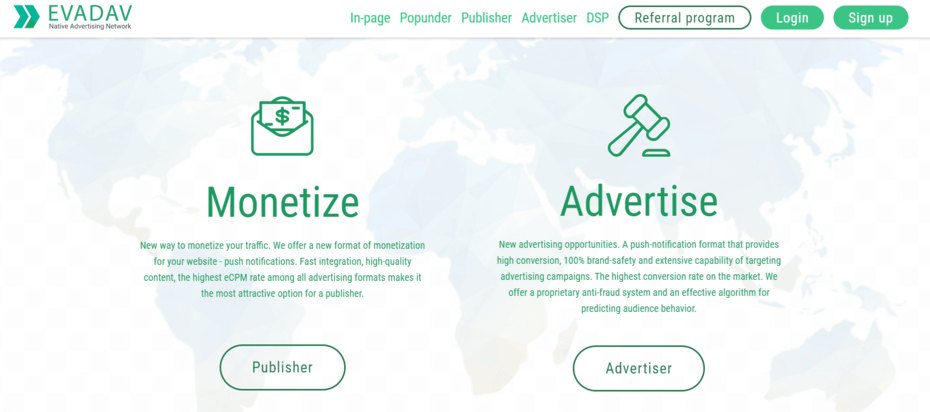
Evadav’s push notification ads present a distinctive and lucrative approach to monetizing websites and applications. The platform stands out for several reasons, with a strong emphasis on innovation and user-friendliness:
Pros:
- High CPM Rates: Evadav offers competitive CPM (Cost Per Mille) rates, ensuring publishers can earn substantial revenue from their traffic. This high earning potential attracts many website owners and app developers.
- User-Friendly Dashboard: Evadav provides a user-friendly and intuitive dashboard that simplifies the ad management process. Publishers can easily set up and customize their push notification campaigns, monitor performance, and make real-time adjustments, enhancing their overall experience.
- Innovative Ad Solutions: Evadav’s push notification ads are known for their innovative and non-intrusive nature. They engage users without disrupting their browsing experience, making them a preferred choice for advertisers seeking effective and unobtrusive advertising solutions.
Cons:
- User Privacy Concerns: Push notification ads, while effective, may raise privacy concerns among users. Some individuals find them intrusive or invasive, potentially leading to negative perceptions of the website or app.
- Ad Fatigue: Overuse of push notification ads can lead to ad fatigue, where users become desensitized or annoyed by frequent notifications. Publishers must strike a balance to avoid overwhelming their audience.
- Competition: As push notification ads gain popularity, the competition among publishers increases. This can make it challenging for newcomers to establish a foothold and maintain high CPM rates in a saturated market.
9. RevenueHits
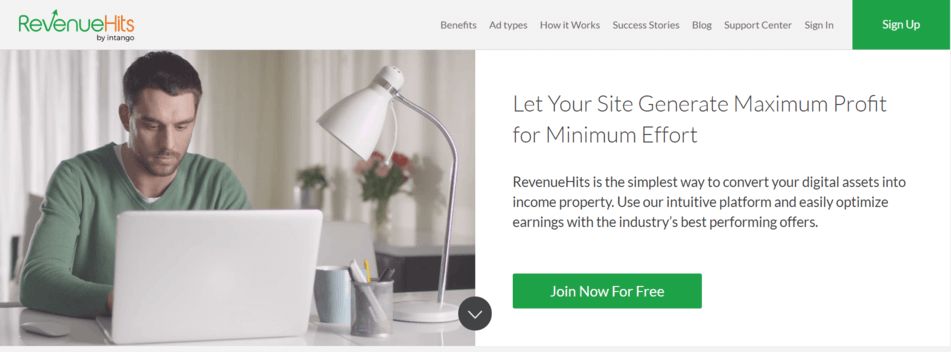
RevenueHits is a prominent player in the digital advertising landscape, renowned for its unwavering commitment to performance-based advertising. This ad network provides advertisers with two key models: CPA (Cost Per Acquisition) and CPL (Cost Per Lead), making it a formidable choice for those aiming to optimize their earnings through user interactions.
Pros:
- Varied Monetization Options: RevenueHits offers a versatile array of advertising formats, including display banners, pop-unders, sliders, and more. This diversity allows publishers to select the ad types that best resonate with their audience, increasing the chances of maximizing revenue.
- Global Reach: The platform boasts a worldwide reach, which means that publishers have the potential to tap into a vast and diverse audience. This broad outreach can translate into increased opportunities for conversions and revenue generation.
- User-Friendly Interface: RevenueHits is praised for its user-friendly interface, making it accessible to both beginners and seasoned publishers. Its simple dashboard and intuitive tools facilitate efficient campaign management and optimization.
Cons:
- Variable Earnings: RevenueHits’ earnings can be somewhat unpredictable. Some users may experience fluctuations in income due to the performance-based nature of the ads, making it important for publishers to closely monitor their campaigns and adapt as needed.
- Quality Control: While RevenueHits offers a wide array of ad formats, maintaining control over ad quality and relevance can be a challenge. Advertisers should exercise caution and review their campaign settings regularly to ensure ads align with their website’s content.
- Limited Customer Support: Some users have reported limited customer support options, which can be frustrating when encountering issues or seeking assistance. Improved customer support services would enhance the overall user experience.
10. ylliX
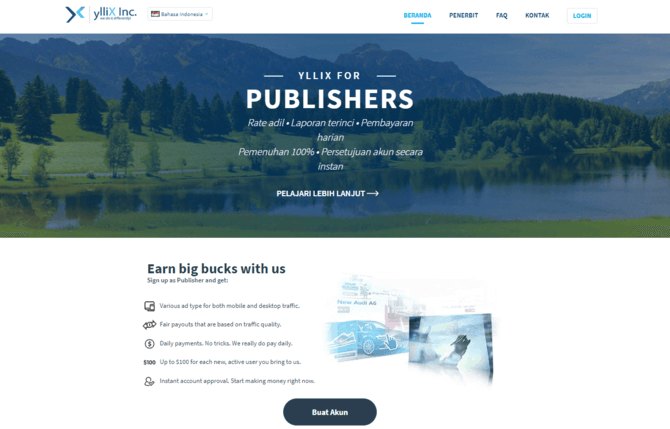
Yllix is a renowned ad network with a robust global reach, providing publishers and advertisers with a plethora of benefits. This platform boasts several noteworthy advantages that make it an attractive choice for individuals seeking monetization opportunities. However, it also has its share of drawbacks that users should consider.
Pros:
- Diverse Ad Formats: Yllix offers a wide array of ad formats, including display ads, pop-under ads, mobile redirects, and full-page ads. This diversity allows publishers to choose the format that best aligns with their website content and audience, enhancing the potential for engagement and revenue.
- User-Friendly Platform: The Yllix platform is known for its user-friendly interface. It provides publishers with easy access to essential tools and features, making ad management, monitoring, and optimization a seamless process, even for beginners.
- Low Minimum Payout: Yllix sets a low minimum payout threshold, which is advantageous for smaller publishers. This means that you can start receiving earnings more quickly without having to accumulate a significant amount before cashing out.
Cons:
- Revenue Fluctuations: Yllix’s global reach can result in fluctuating revenue streams due to varying market conditions and advertiser demand in different regions. This can make it challenging for publishers to predict their earnings consistently.
- Limited Payment Options: While Yllix offers multiple payment methods, some users may find the available options to be somewhat limited compared to other ad networks. This could be inconvenient for those who prefer specific payment methods.
- Quality of Ads: Some publishers have reported concerns regarding the quality of ads served by Yllix, including the possibility of low-quality or intrusive ads that may negatively impact user experience and website reputation. It’s essential to carefully monitor the ads to ensure they align with your website’s content and values.
11. Bidvertiser
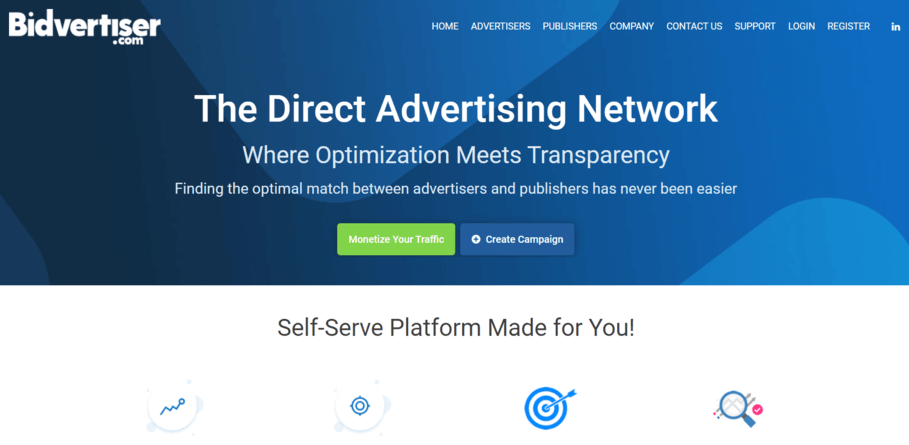
Bidvertiser is a platform with a strong emphasis on native advertising, making it an attractive choice for publishers seeking a nuanced approach to monetizing their websites. Here are three key advantages and disadvantages of using Bidvertiser:
Pros:
- Advanced Targeting Options: Bidvertiser provides a range of advanced targeting features, allowing publishers to hone in on their desired audience. This precision can lead to higher engagement rates and increased revenue as ads are more relevant to the users’ interests.
- Customizable Ad Units: Bidvertiser offers customizable ad units, enabling publishers to seamlessly integrate ads into their website’s design and maintain a consistent user experience. This flexibility helps in maintaining a visually appealing and user-friendly site.
- Competitive Alternative: As an alternative to more mainstream advertising networks, Bidvertiser can be a competitive choice. It may offer more favorable revenue-sharing terms or fill rates, depending on your website’s niche and traffic.
Cons:
- Smaller Network: Bidvertiser’s network is smaller in comparison to giants like Google AdSense, which means that advertisers and ad inventory might be limited in certain niches.
- Quality of Ads: While Bidvertiser allows some customization, the quality and relevance of ads may vary, potentially impacting the user experience and site credibility.
- Payment Threshold: The minimum payout threshold can be relatively high, meaning it might take some time to reach the point where you can withdraw your earnings.
12. PopCash
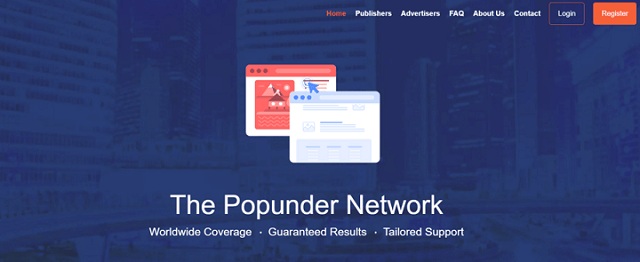
PopCash stands out as a prominent player in the realm of online advertising, specifically known for its expertise in delivering pop-under ads. This ad network boasts several compelling advantages, making it an appealing choice for both advertisers and publishers.
Pros:
- User-Friendly Interface: PopCash prides itself on its intuitive and user-friendly interface. Navigating the platform is a breeze, making it accessible for users of all experience levels. This ease of use saves time and allows users to quickly set up and manage their ad campaigns.
- Competitive Rates: PopCash offers competitive rates, ensuring that advertisers receive value for their investment. This attractive pricing structure can be particularly beneficial for publishers, as higher earnings can be generated from the network’s ads.
- Reliability: PopCash has established a reputation for reliability. It consistently delivers on its promises, providing a stable platform for advertisers and publishers to work with. This reliability can instill confidence in users, ensuring that their campaigns run smoothly and without disruptions.
Cons:
- Limited Ad Formats: While PopCash excels in pop-under ads, it may not be the best choice for those seeking a variety of ad formats. If you require a broader range of advertising options, you may need to explore other networks.
- Traffic Quality: The quality of traffic generated by pop-under ads can vary, and some users may find that the audience engagement isn’t as high as with other ad formats. It’s essential to consider your target audience and campaign objectives when using pop-under ads.
- Competition: Given its popularity, PopCash faces strong competition in the pop-under ad niche. This means that prices and earnings can fluctuate, and it’s essential to stay vigilant and adapt to market changes.
FAQs
Are these alternatives suitable for small websites?
Yes, many of these alternatives are accessible to small websites and blogs. They offer various ad formats and payout options, making them adaptable to different publishing scales.
Do these alternatives work for international traffic?
Absolutely. Most of these alternatives have a global reach and offer competitive rates for international traffic. It’s a great way to monetize diverse audiences.
How do I choose a suitable alternative for my website?
Consider your website’s niche, traffic volume, and the type of content you produce. Research each alternative and choose the one that aligns with your specific needs and goals.
Can I use multiple ad networks simultaneously?
Yes, many publishers use multiple ad networks to maximize their revenue. However, managing them effectively is essential to ensure a positive user experience.
What’s the minimum payout threshold for these alternatives?
The minimum payout varies from one alternative to another. Some have low thresholds, while others require higher earnings before payout.
Do I need to have a certain level of traffic for these alternatives to be effective?
While some alternatives are more suitable for high-traffic websites, others work well for smaller sites. It’s essential to choose the one that matches your traffic volume.
Conclusion
In the world of online advertising, it’s essential to explore diverse options to optimize your revenue. These 10+ Google Adsense alternatives for 2024 offer a range of benefits for publishers. From user-friendly interfaces to competitive payouts, there’s something for everyone. By diversifying your monetization strategies, you can enhance your online earnings and ensure a stable income for the future.


![Free Premium Blogger Templates Download [July 2024] premium blogger template free download](https://www.technovimal.in/wp-content/uploads/2021/06/premium-blogger-template-free-download-100x70.jpg)